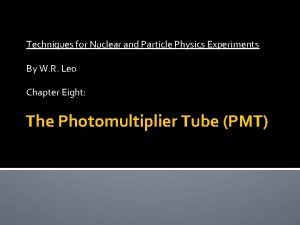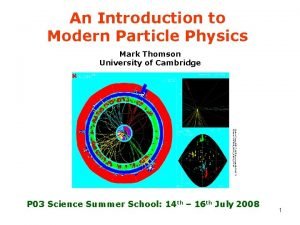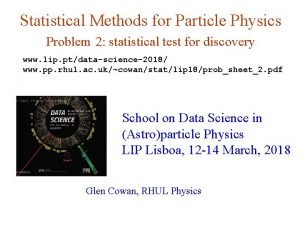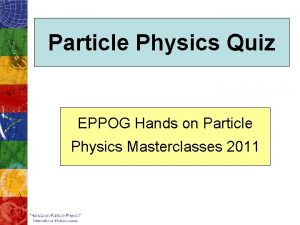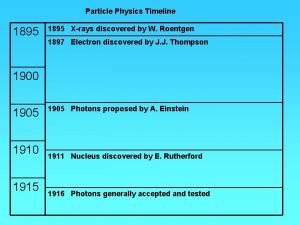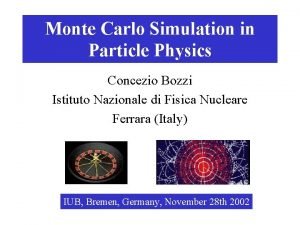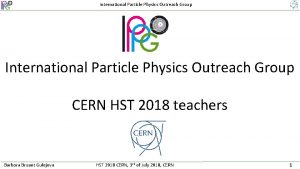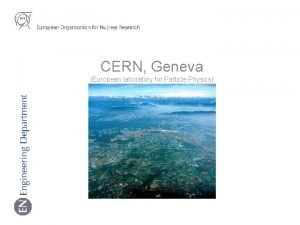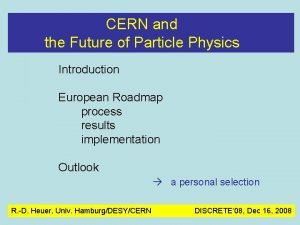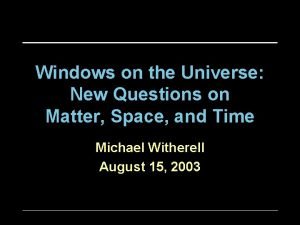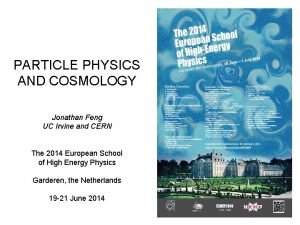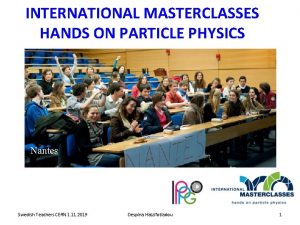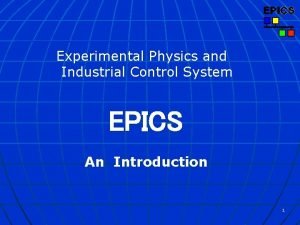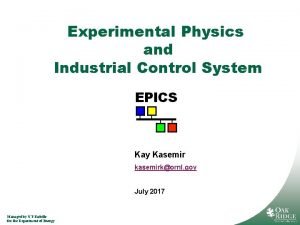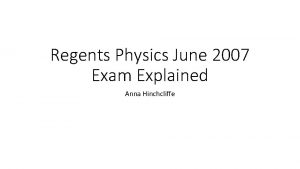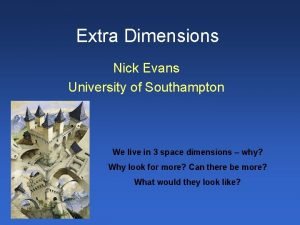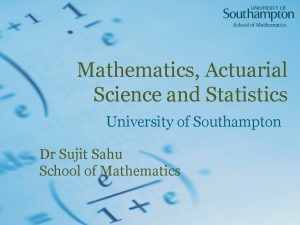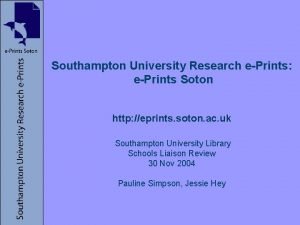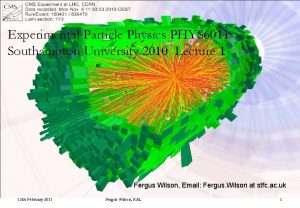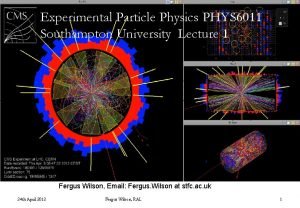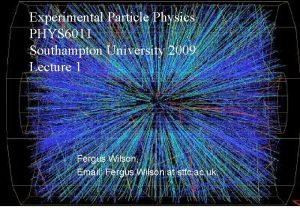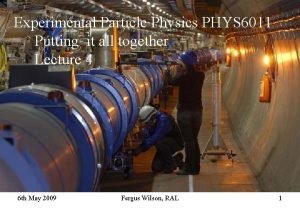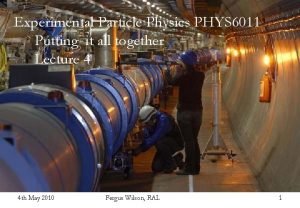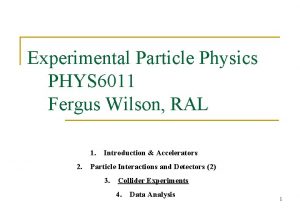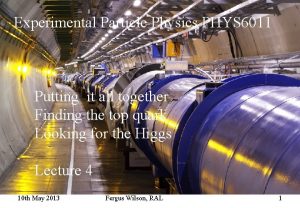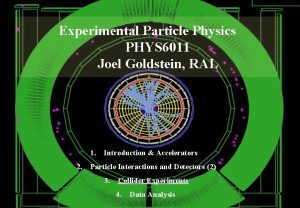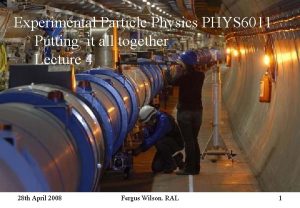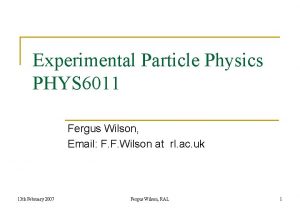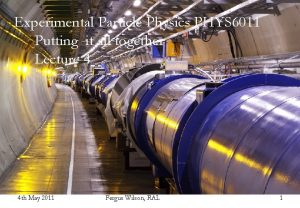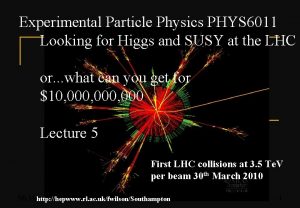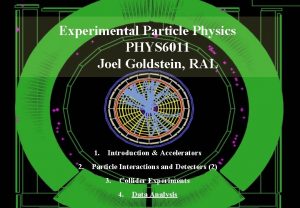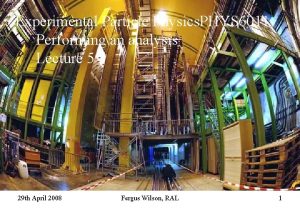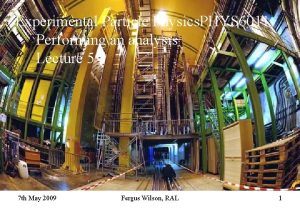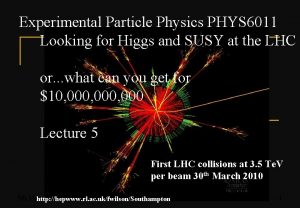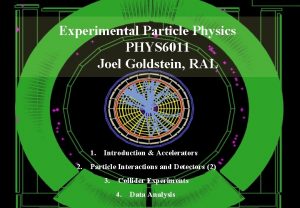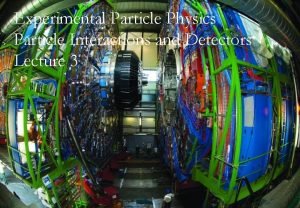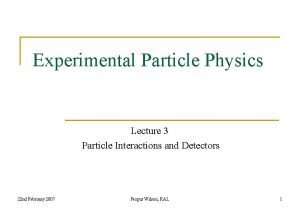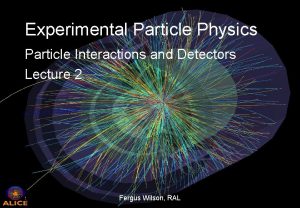Experimental Particle Physics PHYS 6011 Southampton University 2010








































- Slides: 40

Experimental Particle Physics PHYS 6011 Southampton University 2010 Fergus Wilson, Email: Fergus. Wilson at stfc. ac. uk Lecture 1 Feb 16 th 2010 Fergus Wilson, RAL 1

Administrative Points n 5 lectures: q q q n Course Objectives, Lecture Notes, Problem examples: q n Tuesday 11 am : 16 th February and 4 th May Wednesday 12 am: 17 th February and 5 th May Thursday 4 pm: 18 th February http: //hepwww. rl. ac. uk/fwilson/Southampton Resources: q q q K. Wille, “The Physics of Particle Accelerators” D. Green, “The Physics of Particle Detectors” K. Kleinknecht, “Detectors for Particle Radiation” I. R. Kenyon, “Elementary Particle Physics” (chap 3). Martin and Shaw, “Particle Physics” Particle Data Group, http: //pdg. lbl. gov Feb 16 th 2010 Fergus Wilson, RAL 2/39

Syllabus Part 1 – Building a Particle Physics Experiment 1. 2. 3. Accelerators and Sources Interactions with Matter Detectors Part 2 – The LHC and the search for the Higgs 2. 1. 2. 3. What can you get for $10, 000, 000? A modern particle physics experiment How an analysis is performed. Feb 16 th 2010 Fergus Wilson, RAL 3/39

Natural Units n Natural Units: q q n n Energy - Ge. V Mass – Ge. V/c 2 Momentum – Ge. V/c Length and time – Ge. V-1 Use the units that are easiest. 1 e. V = 1. 602 x 10 -19 J Feb 16 th 2010 Fergus Wilson, RAL 4/39

Introduction n Time, energy (temperature) and distance are related: q High momentum : Small distance : High temperature : Early Universe Energy Age (secs) Temp. (K) Observable Size 1 e. V 1013 104 106 Light Years 1 Me. V 1 1010 106 km 10 Te. V 10 -14 1017 10 -2 mm Feb 16 th 2010 Fergus Wilson, RAL 5/39

Feb 16 th 2010 Fergus Wilson, RAL 6/39

Natural Radioactivity n n First discovered in late 1800 s Used as particle source in many significant experiments q q n Common radioisotopes include q q n n Rutherford’s 1906 experiment: elastic scattering α+N Rutherford’s 1917 experiment: inelastic scattering α+N p+X 6 ke. V , τ1/2 = 2. 7 years 90 Sr: 500 ke. V , τ 1/2 = 28. 9 years 241 Am: 5. 5 Me. V α, τ 1/2 = 432 years 210 Po: 5. 41 Me. V α, τ 1/2 = 137 days 55 Fe: Easy to control, predictable flux but low energy Still used for calibrations and tests http: //saturn. jpl. nasa. gov/index. cfm Feb 16 th 2010 Fergus Wilson, RAL 7/39

n n Cosmic Rays History q 1912: First discovered q 1927: First seen in cloud chambers q 1962: First 1020 e. V cosmic ray seen Low energy cosmic rays from Sun q Solar wind (mainly protons) q Neutrinos High energy particles from sun, galaxy and perhaps beyond q Primary: Astronomical sources. q Secondary: Interstellar Gas. q Neutrinos pass through atmosphere and earth q Low energy charged particles trapped in Van Allen Belt q High energy particles interact in atmosphere. q Flux at ground level mainly muons: 100 -200 s-1 m-2 Highest energy ever seen ~1020 e. V Feb 16 th 2010 Fergus Wilson, RAL 8/39

Cosmic Rays Galactic Sources GZK cutoff 1020 Ge. V. Should be impossible to get energies above this due to interaction with CMB unless produced nearby => Black Holes Intergalactic Sources? Feb 16 th 2010 Fergus Wilson, RAL 9/39

Cosmic Ray Experiments n n n Primary source for particle physics experiments for decades Detectors taken to altitude for larger flux/higher energy Positron and many other particles first observed Modern experiments include: 6 cm n Particle astrophysics q Space, atmosphere, surface, underground n Neutrino q Solar, atmospheric n “Dark Matter” searches Still useful for calibration and testing Which direction is the e+ moving (up or down)? Is the B-field in or out of the page? Feb 16 th 2010 Fergus Wilson, RAL 10/39

Cosmic Rays - Pierre Auger Project Surface Array 1600 detector stations 1. 5 km spacing 3000 km 2 Feb 16 th 2010 60 km Fergus Wilson, RAL Fluorescence Detectors 4 Telescope enclosures 6 Telescopes per enclosure 24 Telescopes total 11/39

Active Galactic Nuclei and cosmic rays E>5. 7 x 10 19 Ge. V Highest energy cosmic rays seem to be associated with Active galactic nuclei. www. auger. org Feb 16 th 2010 Fergus Wilson, RAL 12/39

Dark Energy and Dark Matter n n Most of the Universe is invisible. Dark Energy: q q n Dark Matter: q n Just like ordinary matter but not visible (does not give off light). 1: Baryonic Dark Matter q q n Exerts a negative pressure on the Universe Increases the acceleration of the galaxies. ~2% of the Universe MACHOS, dwarf stars, etc… 2: Non-Baryonic Dark Matter q q q ~20% of the Universe Hot (neutrinos) and Cold (WIMPS, axions, neutralinos). Expected to be mostly Cold Feb 16 th 2010 Fergus Wilson, RAL 13/39

Dark Matter - DAMA http: //arxiv. org/abs/0804. 2741 Feb 16 th 2010 Fergus Wilson, RAL http: //people. roma 2. infn. it/~dama 1. As the earth goes round the sun, its velocity relative to the galaxy changes by +/-30 km 2. Look for nuclear recoil in Na. I as nucleus interacts with “dark matter” particle. 3. Expect to see a change in the rate of interactions every six months 4. But is there really a pattern? and is it really dark matter? 14/39

Neutrinos – Nuclear Reactors and the Sun n n n Reactors – Nuclear Fission Sun – Nuclear Fusion But still weak interactions. Well understood. Huge fluxes of Me. V neutrons and electron neutrinos. But low energy. First direct neutrino observation in 1955. Feb 16 th 2010 Fergus Wilson, RAL 15/39

Neutrino Oscillation n Neutrinos “Oscillate”: q q q Feb 16 th 2010 Fergus Wilson, RAL Can change from one type to another. Implies ν have mass. Oscillation experiments can only measure difference in squared mass Δm 2 16/39

Some Neutrino Detectors – Present and Future T 2 K hepwww. rl. ac. uk/public/groups/t 2 k/T 2 K. html Super-Kamiokande http: //www-sk. icrr. u-tokyo. ac. jp/ Feb 16 th 2010 Antares http: //antares. in 2 p 3. fr Ice Cube http: //icecube. wisc. edu/ Fergus Wilson, RAL KM 3 Ne. T http: //www. km 3 net. org 17/39

Particle Sources Want intense monochromatic beams on demand: 1. Make some particles • Electrons: metal + few e. V of thermal energy • Protons/nuclei: completely ionise gas 2. Accelerate them in the lab +ve -ve e- K. E. = e×V V Feb 16 th 2010 Fergus Wilson, RAL 18/39

Creating Electrons n n n Feb 16 th 2010 Fergus Wilson, RAL Triode Gun Current: 1 A Voltage: 50 k. V Cathode is held at 50 V above anode (so no electrons escape). When triggered, cathode voltage reduced to 0 V. Electrons flow through grid. Pulse length: ~1 ns 19/39

Creating Positrons n n n Example of how it will be done at the ILC High energy e- emit photons in undulator. Photons hit target (tungsten) Positrons and electrons emitted by pair-production. Electrons removed, positrons accelerated. Inefficient: 1 positron for every 105 high energy electrons. Example of how it is done at SLAC Feb 16 th 2010 Fergus Wilson, RAL 20/39

Creating Protons – PIG (Penning Ion Gauge) n n Hydrogen gas bottle n n Tevatron Feb 16 th 2010 Fergus Wilson, RAL Ion source (e. g. H 2) introduced as a gas and ionised. Magnetic field 0. 01 T perpendicular to E-field causes ions to spiral along B-field lines. Low pressure needed to keep mean-free path long (10 -3 Torr). Modern methods are more complicated. 21/39

Anti-Proton Production at CERN Protons are accelerated in a linear accelerator, booster, and proton synchroton (PS) up to 27 Ge. V. These protons hit a heavy target (Beryllium). In the interaction of the protons and the target nuclei many particle-antiparticle pairs are created out of the energy, in some cases proton-antiproton pairs. Some of the antiprotons are caught in the antiproton cooler (AC) and stored in the antiproton accumulator (AA). From there they are transferred to the low energy antiproton ring (LEAR) where experiments take place. Feb 16 th 2010 Fergus Wilson, RAL 22/39

DC Accelerators – Cockcroft Walton How it works Cockcroft and Walton’s Original Design (~1932) n n Feb 16 th 2010 Fergus Wilson, RAL Fermilab’s 750 k. V Cockroft-Walton DC accelerators quickly become impractical Air breaks down at ~1 MV/m 23/39

DC Accelerators – Van der Graff Van de Graaf at MIT (25 MV) Feb 16 th 2010 Fergus Wilson, RAL 24/39

Cyclotrons n Berkeley (1929) n n n Utilise motion in magnetic field: p (Ge. V/c) = 0. 3 q B R Apply AC to two halves Lawrence achieved Me. V particles with 28 cm diameter Magnet size scales with momentum… Orsay (2000) n Still used for q q Proton Therapy PSI Feb 16 th 2010 q Medical Therapy Creating Radioisotopes Nuclear Science Fergus Wilson, RAL 25/39

Cyclotrons - Variations n Cyclotron limitations: q q n Energy limit is quite low: 25 Me. V per charge Non-relativistic velocity v < 0. 15 c Alternatives: q Syncrocyclotron n q Isocyclotron n n q Keep magnetic field constant but decrease RF frequency as energy increases to compensate for relativistic effects. Keep RF frequency the same but increase the radial magnetic field so that cyclotron frequency remains the same: Can reach ~600 Me. V Synchrotron n For very high energies. See later… Feb 16 th 2010 Fergus Wilson, RAL 26/39

Linear Accelerators For energies greater than few Me. V: n Use multiple stages n RF easier to generate and handle n Bunches travel through resonant cavities n Spacing and/or frequency changes with velocity n Can achieve 10 MV/m and higher n 3 km long Stanford Linac reached 45 Ge. V n 30 km ILC would reach 250 Ge. V. Feb 16 th 2010 Fergus Wilson, RAL 27/39

Superconducting Cavities & Klystron Early Warning Radar Feb 16 th 2010 SLAC Klystron Hall Fergus Wilson, RAL 28/39

Synchrotrons n n p (Ge. V/c) = 0. 3 q B R Cyclotron has constant B, increasing R Increase B keeping R constant: q variable current electromagnets q particles can travel in small diameter vacuum pipe q single cavity can accelerate particles each turn q efficient use of space and equipment Discrete components in ring q cavities q dipoles (bending) q quadrupoles (focusing) q sextuples (achromaticity) q diagnostics q control Feb 16 th 2010 Fergus Wilson, RAL 29/39

Synchrotron Radiation n n n Accelerated charges radiate Average power loss per particle: Quantum process → spread in energy For a given energy ~ 1/mass 4 q (this comes from γ in the Power loss equation) Electron losses much larger than proton q High energy electron machines have very large or infinite R (i. e. linear). Pulsed, intense X-ray source may be useful for some things. . Feb 16 th 2010 Fergus Wilson, RAL 30/39

Real Synchrotrons Grenoble, France Bevatron, LBNL, USA DIAMOND, RAL, UK Feb 16 th 2010 Fergus Wilson, RAL 31/39

Fixed Target Experiments Beam incident on stationary target n Interaction products have large momentum in forward direction n Large “wasted” energy small s n Intense beams/large target high rate n Secondary beams can be made. Feb 16 th 2010 Fergus Wilson, RAL 32/39

Fixed Target - Neutrino Beams p beam Pion beam 700 m n n n 700 km Fermilab sends a νμ beam to Minnesota Looking for oscillations Detector at bottom of mine shaft Feb 16 th 2010 Fergus Wilson, RAL 33/39

Colliders n n Incoming momenta cancel s = 2 Ebeam Same magnetic field deflects opposite charges in opposite directions Antiparticle accelerator free! q particle/antiparticle quantum numbers also cancel Technically challenging particles per bunch frequency Feb 16 th 2010 bunch size #bunches Fergus Wilson, RAL 34/39

Different Colliders n p anti-p q q n energy frontier difficult to interpret limited by anti-p production SPS, Tevatron n q q high luminosity energy frontier LHC n some plans exist Feb 16 th 2010 ep q + q e+ eq relatively easy analysis q high energies difficult q LEP, PEP, ILC. . . q pp q n n Fergus Wilson, RAL n proton structure HERA ion q quark gluon plasma q RHIC, LHC q Muon Collider !!! 35/39

Complexes n n Synchrotrons can’t accelerate particles from rest Designed for specific energy range, normally about factor of 10 q accelerators are linked into complexes Feb 16 th 2010 Fergus Wilson, RAL 36/39

Collider Parameters Full details at pdg. lbl. gov Feb 16 th 2010 Fergus Wilson, RAL 37/39

Some notable accelerators Type Name Cockcroft. Walton Size Start Year Place Energy 3 m 1932 Cambridge 0. 7 Me. V Cyclotron 9” 9” 1931 Brookhaven 1. 0 Me. V Cyclotron 184” 1942 Brookhaven 100 Me. V Synchrotron Cosmotron 72 m 1953 Brookhaven 3. 3 Ge. V Synchrotron AGS 72 m 1960 Brookhaven 33 Ge. V Collider LEP 27 km 1995 CERN 104 Ge. V Collider LHC 27 km 2009! CERN 7 Te. V Feb 16 th 2010 Fergus Wilson, RAL 38/39

Summary of Lecture I n n Admin Particle Sources q q n n n Antiparticle Production Collider Parameters Natural Radiation Cosmic Rays Reactors Accelerators q q q Cockcroft Walton Van der Graaf Cyclotron Synchrotron Linear Accelerator Feb 16 th 2010 Fergus Wilson, RAL 39/39

Next Time. . . Charged particle interactions and detectors Feb 16 th 2010 Fergus Wilson, RAL 40/39
 Southampton enabling services
Southampton enabling services Experimental vs non experimental
Experimental vs non experimental Cross-sectional correlational design
Cross-sectional correlational design Experimental vs non experimental research
Experimental vs non experimental research Non experimental design vs experimental
Non experimental design vs experimental Experimental vs non experimental
Experimental vs non experimental University physics with modern physics fifteenth edition
University physics with modern physics fifteenth edition Pmt particle physics
Pmt particle physics Mark thomson modern particle physics
Mark thomson modern particle physics Particle physics
Particle physics Particle physics practice quiz
Particle physics practice quiz Particle physics timeline
Particle physics timeline Concezio bozzi
Concezio bozzi Cern particle physics
Cern particle physics European laboratory for particle physics
European laboratory for particle physics Cern particle physics
Cern particle physics Particle physics
Particle physics Form factor particle physics
Form factor particle physics International masterclasses hands on particle physics
International masterclasses hands on particle physics Experimental physics and industrial control system
Experimental physics and industrial control system Experimental physics and industrial control system
Experimental physics and industrial control system Experimental physics and industrial control system
Experimental physics and industrial control system June 2010 physics regents answers
June 2010 physics regents answers Pgr tracker
Pgr tracker Eprints soton
Eprints soton Southampton city council housing
Southampton city council housing Southampton township school district
Southampton township school district Public health england
Public health england Southampton county, virginia plantations
Southampton county, virginia plantations Sussed soton
Sussed soton New vevox app
New vevox app Southampton district energy scheme
Southampton district energy scheme Matt ryan southampton
Matt ryan southampton Dimensions southampton
Dimensions southampton Mike santer
Mike santer Southampton actuarial science
Southampton actuarial science Nick evans southampton
Nick evans southampton Will baker southampton
Will baker southampton Southampton education school
Southampton education school Eprints soton
Eprints soton Agresso southampton
Agresso southampton







